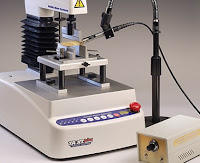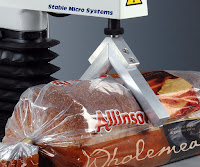Texture Analysis techniques
Dough
The main properties of the dough itself that are tailored using enzymes are softness, extensibility and stickiness.In bakery, measurements of dough and gluten extensibility are important in pre-determining the rise qualities and structure of the finished product. Stable Micro Systems offer two solutions for measuring dough extensibility, both widely used in academic environments and bakeries. Firstly, the Dobrascycyk-Roberts Dough Inflation System enables the rheological properties of both dough and gluten to be measured during biaxial stretching.
 |
| Dobrascycyk-Roberts Dough Inflation System |
In the Dobrascycyk-Roberts Dough Inflation System, conditions similar to the strain experienced during proofing and baking around a slowly expanding gas cell are reproduced. The device inflates a sheet of dough by volume displacement of air using a piston driven by a Texture Analyser. Pressure during inflation is measured using a pressure transducer, and the volume of the inflating dough sheet is calculated from piston displacement.
Dough rheological properties (stress, strain and viscosity) are then calculated directly from pressure, volume, and time using fundamental equations. The procedure requires minimum handling of the dough when preparing samples. Typical results include baking strength, tenacity, extensibility and elasticity.
 |
| Kieffer Dough and Gluten Extensibility Rig |
Parallel tests of dough and gluten can reveal particular characteristics arising from homogenisation, long relaxation times or from adding oxidants, salts, emulsifiers or enzymes. The maximum force (resistance to extension) and distance to break (extensibility) are measured using this rig.
 |
| Warburtons Dough Stickiness System |
The force measurement during this action obtains the compression peak and compression area of the dough, indicators of its consistency (firmness/softness). As the blade is withdrawn upwards, Exponent software calculates the adhesion peak and adhesion area. The higher the peak, and/or larger the area, the stickier the dough. This rig enables more realistic assessment of dough stickiness than traditional open techniques as it minimises the dough’s exposure to atmospheric variables by testing under controlled conditions.
 |
| 12mm cylindrical probe |
Crust
A fresh loaf of bread has a crust that is much crispier than the interior, a property that degrades over the staling period. This property can be measured using a penetration test using a cylindrical penetration probe. A crispier crust will show a series of high force peaks followed by a drop once the probe reaches the interior, as opposed to a loaf that has simply gone stale and hard, which will show a monotonous high resistance to the probe. The measurement of Peak Count and Linear Distance will give a good indication of crispness. This test can be further enhanced by the use of an Acoustic Envelope Detector. This allows quantitative measurement of the sound pressure level produced during a crust penetration, which can be related directly to the sounds heard when a customer cuts through the crust with a knife or takes a bite from the crust of a bread slice. |
| Acoustic Envelope Detector |
Crumb
The Bread Resilience method included in Exponent software measures two key properties in staling of bread crumb: elasticity and firmness. It uses a radiused 36mm cylinder probe to test a stack of two bread slices. This method was developed to mimic a manual test performed by the line operators of a large industrial bakery. The manual test involved squashing two stacked slices of bread with a thumb by approximately 60% for 2 seconds. After allowing the bread to recover for approximately 15 seconds a visual assessment was made on the % of recovery. This was the factory’s definition of ‘resilience’. This manual method has inherent variability and is very subjective. The Bread Resilience method replicates this manual test in a controlled way giving an objective resilience result.
 |
| Bread firmness test using a cylinder probe |
Fresh bread shows an immediate return to its initial state after stress release, whereas stale bread shows plastic deformation resulting from cracking and crumbling upon stress application, preventing the bread from springing back into place. These cracks might be microscopic; bread resilience testing will show irreversible damage for whatever reason it has occurred.
To measure staling objectively, perform firmness and resilience tests during the storage period and measure away from the crust to avoid dry edge effects. It is recommended to use a radiused probe such as the P/36R to prevent cutting at the edges.
 |
| SMS/Miller-Hoseney Toughness Rig |
 |
| Bread V Squeeze Rig |
Loaf
The test commonly used by a consumer to test loaf softness is the ‘squeeze test’, squashing it between the thumb and fingers, creating a ‘V’ shape with the hand. Staleness is equated to increased firmness of a loaf of bread on the store shelf. The Bread V Squeeze Rig enables testing of the softness and springiness of both packaged and unpackaged loaves, giving a good indication of freshness.
The rig imitates the customer’s squeeze process and allows repeatable, scientific analysis of the freshness and appeal of bread. It consists of ‘V’ shaped rounded ‘fingers’, which are lowered onto a packaged or unpackaged loaf, and the force required to compress the bread is measured. Post-test calculations are then used as an indication of freshness – the lower the force and higher the value of springiness, the fresher the loaf. This non-destructive test offers simplicity and speed as the loaf requires no sample preparation and can be analysed within the packaging.
 |
| Volscan Profiler |
The rapid 3-dimensional digitisation of products enables the automatic calculation of several detailed dimensional parameters, the results of which may be mathematically manipulated for immediate use or future retrieval in a variety of data formats.
This technique enables manufacturers to have a precise and fast method for the measurement of the volume, density and dimensions of bread to help control and monitor their manufacture.
During a test, the bread loaf is speared at each end. Parameters for each batch under test are entered into the software by the operator and include sample ID, name, date, and bakery-specific parameters such as flour weight. The product is then automatically weighed and an eye-safe laser device is used to scan vertically to measure the contours of the product at selectable intervals whilst it rotates.
Each interval consists of 400 data points providing a detailed profile of the product. This assessment can be performed rapidly, the results being obtained in a period ranging from a few seconds to a few minutes depending upon the chosen interval (0.05mm to 50mm) and the preferred precision. Temperature of the testing chamber is measured automatically.
Due to the samples being scanned by the laser in a linear manner the mounted sample can be analysed in ‘slices’. This means that every measurement step increment possesses data and statistics of its own such as circumference, average radius and minimal enclosing circle. This provides more detailed dimensional analysis than any other similar measuring instrument.
Due to the rapid development of biochemistry and enzyme technology, as well as increasing interest in enzyme applications for the baking industry, more and improved enzyme products will continue to appear on the market. There will also be more reports and studies giving a better understanding of the mechanisms of baking enzymes, leading to further improved products. The improvements in products resulting from this new technology is only proven by the quantification of property alterations using techniques such as Texture Analysis.
A whole host of Texture Analysis techniques can be used to test other aspects of a bread loaf, from the flow properties of the flour to the packaging used for the final product. The range of Stable Micro Systems Texture Analysers combines ease of use with automatic data collection and rapid project-based data analysis. To discover our whole range of testing techniques, contact Stable Micro Systems today.
References
‘Not a stale subject’, Bakery Business,Taylor 1998
‘Characterisation of the staling process of wholemeal bread’, Polish Journal of Food and Nutrition Sciences, Fik 2000
‘Strategies to stop staling’, Baking and Snack, Stauffer 1996
‘Effects of enzyme preparations for baking, mixing time and resting time on bread quality and bread staling’, Food Chemistry, Sahlstrom 1996
‘Comparison of methods for the assessment of staling in bread’, Food Chemistry, Sidhu 1996
‘Synergistic effect of enzymes for breadbaking’, American Association of Cereal Chemists, Qi Si 1997
For more information on how to measure texture, please visit the Texture Analysis Properties section on our website.
 The TA.XTplus texture analyser is part of a family of texture analysis instruments and equipment from Stable Micro Systems. An extensive portfolio of specialist attachments is available to measure and analyse the textural properties of a huge range of food products. Our technical experts can also custom design instrument fixtures according to individual specifications.
The TA.XTplus texture analyser is part of a family of texture analysis instruments and equipment from Stable Micro Systems. An extensive portfolio of specialist attachments is available to measure and analyse the textural properties of a huge range of food products. Our technical experts can also custom design instrument fixtures according to individual specifications.No-one understands texture analysis like we do!
To discuss your specific test requirements, click here...
|





No comments:
Post a Comment